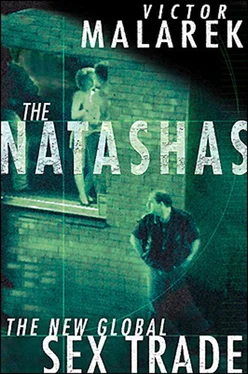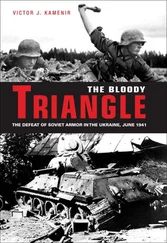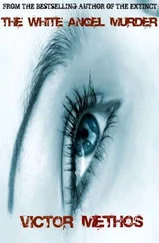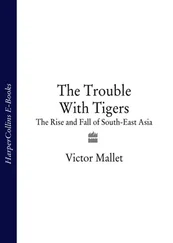Anna Diamantopoulou, European commissioner responsible for Employment and Social Affairs, lamented the savagery of modern-day trafficking in a speech to an anti-trafficking conference in Brussels in September 2002:
It is a booming industry, run with ruthless efficiency by powerful, multinational criminal networks… These are not casual criminals. They run well-funded, well-organized, influential organizations. They know their business inside out and respond to changes in the market with a speed unmatched by even the most competitive corporations. Their expertise and their ability to exploit the market are surpassed only by their disregard for human life. Women are bought, sold and hired out like any other product. The bottom line is profit.
The profits are, in fact, unseemly. Interpol estimates that each exploited woman can bring in $75,000 to $250,000 a year. Pimps often brag that a woman purchased for $1500 can bring in $100 an hour… making back their investment in just a few nights. According to Willy W. Bruggeman, deputy director of the European Union–wide police intelligence agency Europol, the trade in human beings earns up to $12 billion euros worldwide every year.
The trade is also widespread. Bruggeman notes that all member states of the European Union “have reported the presence of foreign OC [organized crime] groups” in the trafficking of human beings. And it’s not just Europe. As head of the UN Office for Drug Control and Crime Prevention in 2001, Pino Arlacchi observed that trafficking in human beings is “one of the most globalized markets in the world today… one that almost no country is immune from.” Arlacchi also pointed out that as the fastest-growing international crime, “it is now the third most profitable business for organized crime, behind drugs and arms.”
The outlook is sobering. Organized crime groups are increasingly moving toward large hierarchical structures. They no longer want to deal with middlemen. They want to run the schemes for themselves—from recruitment to final exploitation. According to Europol’s 2002 Crime Assessment report dealing with Trafficking in Human Beings into the European Union, this will “increase the profitability, efficiency and security of operations.” It also “reflects a desire to be more in control of all elements of the trade, perhaps indicating the elevation of trafficking in human beings within the wider portfolio of OC criminal activity.”
Urgent cables, reports and alerts from criminal intelligence– gathering agencies and police forces around the world paint a frightening picture of these heightened activities. The most formidable threat to vulnerable Slavic women today is Russian Organized Crime (ROC). Wherever women and girls from Eastern European countries are being trafficked, the iron fist of ROC is sure to be playing a hand. Their syndicates, now numbering more than 200, are active in fifty-eight countries around the world, including Austria, Germany, Belgium, Holland, Italy, Hungary, Poland, Turkey, Israel, Canada and the United States. Most have their grip on prostitution rackets, though they’re also behind huge extortion and fraud schemes.
These ROC syndicates have formed a powerful global criminal axis with the four principal powers in international organized crime: the Italian Mafia, the Colombian drug cartels, the Chinese Triads and the Japanese Yakuza. According to Italian police, in some parts of Italy ROC’s influence is already greater than that of the Mafia. The Russian mobs have also established strategic alliances with U.S. crime groups and biker gangs and with Ukrainian, Polish, Hungarian, Czech, Turkish, Serbian, Israeli and Albanian gangs.
Political leaders in that corner of the world are repeatedly citing ROC’s increasing involvement in the trafficking of women from Eastern Europe. Bulgarian Interior Ministry Chief Secretary Bozhidar Popov stated publicly that Russian criminals are using his country as a transit point to move Russian, Ukrainian, Georgian and Chechen women into Turkey, Greece and Western Europe for prostitution. Lithuanian Member of Parliament Vilija Aleknaite-Abramikiene reported that Russian goons are behind the trafficking of women for the sex industry in his country. One of the more notorious gangs under intense investigation by several European police forces is the powerful Izmailovskaya syndicate. Another group, the feared Mogilevich organization, runs strip clubs in Prague, Riga and Kyiv; the clubs are teeming with trafficked women. In Russia’s Far East, vicious gangs in Vladivostok direct the supply of women to brothels and clubs in Hong Kong, Taiwan, South Korea, Thailand and Macao. Roughly a dozen Russian-run prostitution rings are currently operating in Israel. A November 1997 report by Israel’s Women’s Network concluded that ROC controls the sex industry throughout the nation. And police in the United Arab Emirates state that Russian crime organizations are heavily engaged in local prostitution of trafficked women.
Intelligence gathered by the FBI and the Royal Canadian Mounted Police over the past decade reveals that ROC has been expanding into the lucrative American and Canadian sex markets by exporting Russian and Ukrainian women into the strip club, peep show, escort and massage parlor trade in North America. FBI headquarters in Washington, D.C., has amassed impressive dossiers showing that the Izmailovskaya, Dagestantsy, Solntsenskaya and Kazanskaya Russian crime syndicates have made inroads into the prostitution rackets throughout the country. Local ROC gangs in New York and New Jersey have even tried to muscle in on trafficking and prostitution activities run by other criminal organizations. In the summer of 1998, for example, crime boss Vyacheslav Ivankov—a.k.a. “the Red Godfather” and purported head of the Solntsevskaya syndicate operations in the U.S.—unleashed his goons in an effort to gain control of dance and modeling agencies that were importing trafficked Eastern European women for the flesh market. The FBI estimates that more than a dozen of these Russian-fronted dance and modeling agencies, each employing 60 to 200 East European women, supply women to the profusion of strip bars and peep shows run by the Italian Mafia in New York and New Jersey.
ROC, as well as a host of other Eastern European crime groups, is also expanding into Canada, particularly into Toronto, Montreal and Vancouver. According to the 2002 Criminal Intelligence Service of Canada report on organized crime in Canada, “East European–based organized crime groups in Canada are well connected to criminal counterparts in Russia, Europe and the United States and function as integral parts of large-scale international organized crime networks.” The CISC report notes that these crime groups are “known for their entrepreneurial and opportunistic tendencies, are quite adaptable and are strongly motivated by profit. As a result, they will engage in any type of criminal activity or attempt to penetrate any market sector they view as being vulnerable for exploitation,” including prostitution.
Canadian and U.S. police intelligence reports also reveal that control of the trafficking trade in North America remains, for the most part, in the hands of smaller émigré gangs that are loosely connected to considerably more powerful organized crime syndicates abroad. As history shows, gangsters operating in foreign countries use their criminal connections in the motherland to prey on their own. This situation is no different. The majority of trafficking victims are recruited and sold by their own people.
The ROC, however, is not the only player by far. Enmeshed in the business are Ukrainian, Polish, Israeli, Czech, Georgian, Hungarian, Romanian, Bulgarian, Serbian and Albanian gangs, as well as the Italian Mafia, Chinese Triads and the Japanese Yakuza. International police reports from virtually every capital around the globe are replete with warnings about the involvement of these groups in the trafficking of women. Yet whatever the structure or the connections, the gangsters involved in the trade have two very powerful weapons at their disposal: an army of muscle to instill fear, and lots of money to influence and corrupt.
Читать дальше












